Kansept Knives is based in Yanjiyang, the city of knives in China. The brand combines innovation and fine craftsmanship to bring forth high-quality functional knives. The company was founded in 2020 by Kim Ning after parting ways with Kizer Cutlery. He worked as production manager at Kizerand had designed several Kizer knives like the Bantam, Vigor, and Shoal. After establishing Kansept, the company has designed more creative and artistic knives than merely utilitarian and minimalist options.
The word Kansept is a reformation of the word Concept, and resonates structures and ways of making knives. They use concept-driven approach to produce knives. Their product range includes folding knives, fixed blades, and accessories. It uses high-quality blade materials like CPM S35CV, CPM 20CV, Damascus, M390, 154CM, and D2. On the other hand, their handle materials include Micarta, Carbon Fiber, Timascus, Aluminum, G10, Brass, and Copper. Their designs are mostly in-house and collaborative with other talented knife designers.
Kansept Main Street Review

The Kansept Main Street is a budget-friendly Chinese folding knife with an overall length of 7.95”, blade length of 3.4” and weighs just 4.5 ounces. It features 154CM blade with G10 handle, a crossbar lock, and thumb stud.
Kansept Main Street Prices |
||
|---|---|---|
 |
 |
Check Price at Blade HQ |
 |
Check Price at Chicago Knife Works | |
Summary of Kansept Main Street specs:
First Impressions of Kansept Main Street
The Kansept Main Street came in a regular branded cardboard box with all the specs mentioned outside, along with a manual, and the knife itself.
The knife itself looked exactly as was seen on the company website, with fine finishing and contouring.
The knife looked very attractive at first sight with its red and black lava-shaped textured scales. The thumb stud was clearly visible outside and deployed really well and easily. The steel liners came with jimping, but the jimping on the spine was less deep. However, it is much exaggerated and allows you to choke hold the knife to use it in left, right, and center direction. It even works well for chopping vegetables on a surface of chopping board. The width of the blade along the belly allows for precise and smooth cuts. The cutting edge feels really great as well. The Sheepsfoot blade along with the high flat grind is great for everyday cutting tasks.
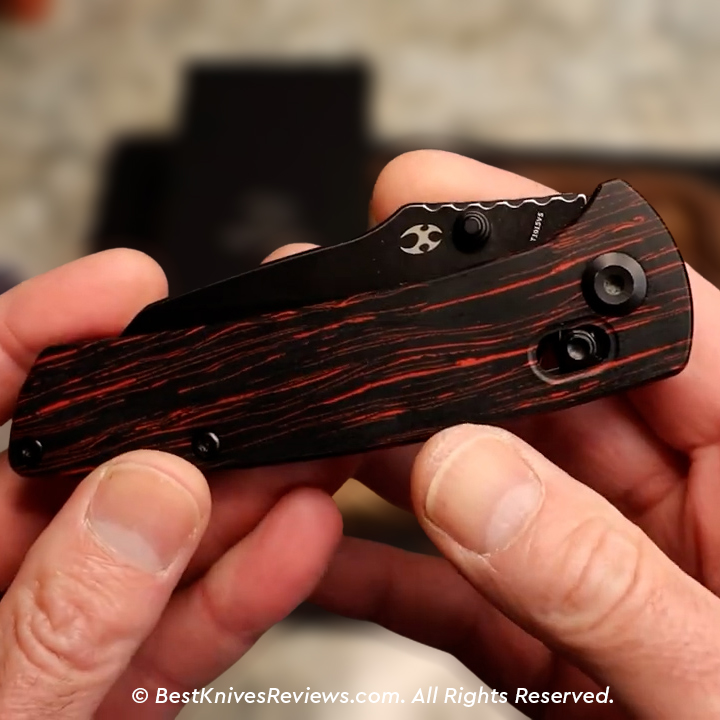
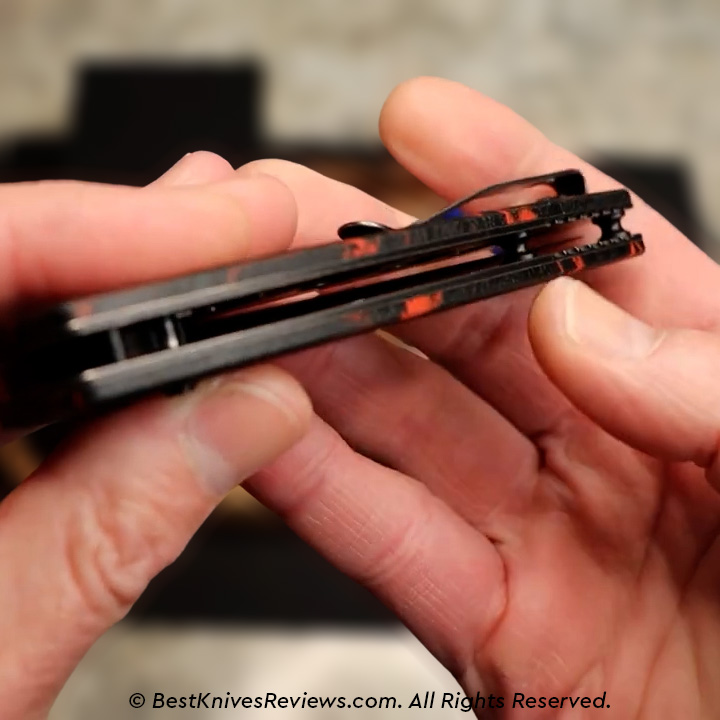
The blade stock thickness is also ideal for performing light to medium EDC tasks. We also liked that the blade was perfectly straight, and allowed the user to reach the cutting edge fairly easily. The screws are very much visible on either sides of the jimping along the blade’s spine, and feels smooth yet straight.
The deep carry clip is not reversible, but is positioned and placed well. It also works well and does the job of concealing the knife in the pocket. The knife does not have a lanyard hole though, but has enough room and size for a comfortable grip.
The black stonewash finish of the blade is a good choice, since it hardly ever shows any signs of scratches, but does require good maintenance. You need to keep the finish intact by keeping it clean and do not leave it in food acids for too long.
The skeletonized stainless steel liners do a great job of weight reduction. The flat-sided scales are smooth yet non-slippery. The G10 is a very reliable and light material for foldable knives handle. It is attractive yet grippy, and would no slip out of your hand easily. The chamfering on the edges is done very nicely.
The crossbar lock latches itself well and works very smoothly without any blade play.
The Blade of Kansept Main Street
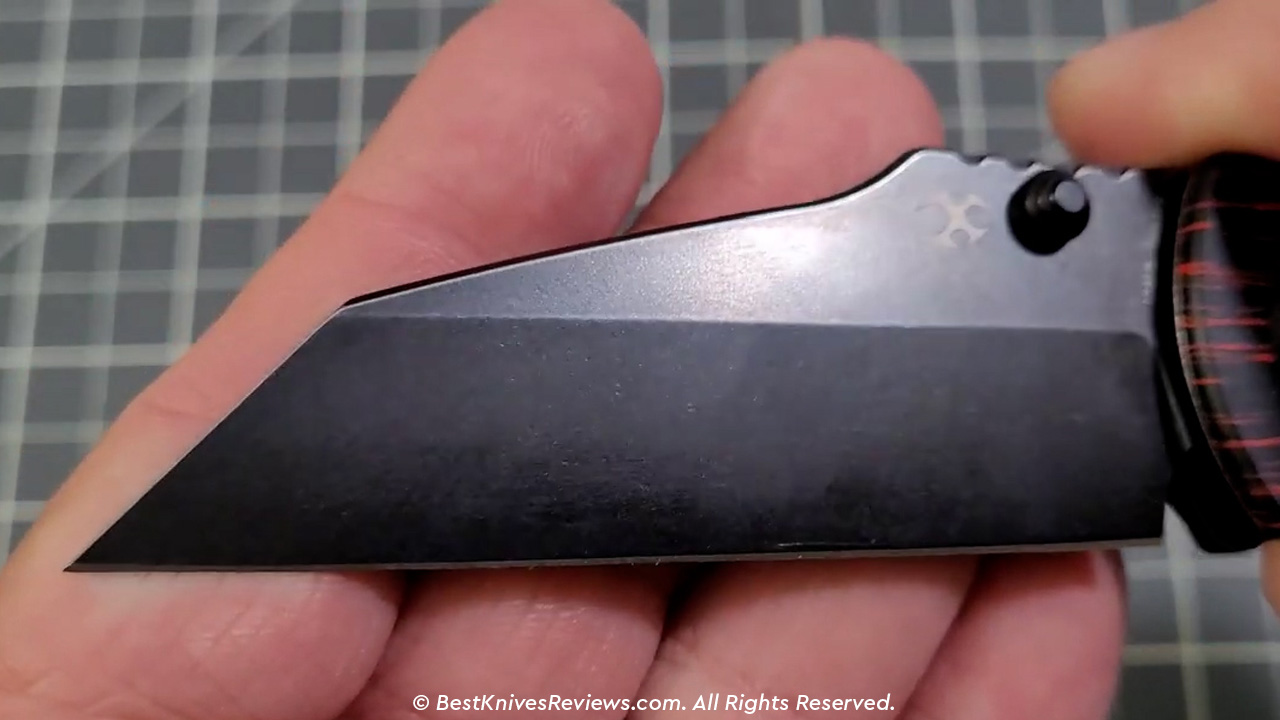
The reverse tanto blade shape gives the Main Street an edge with completely straight 3.25” cutting edge with high flat grind. The spine is refined with jimping for thumb traction above the thumb stud before curving towards the tip and thinning. The widest point of the blade is at 1.25” with a blocky and tall profile. The flat grind lines run parallel to the cutting edge from steep ricasso to where the spine turns down the tip.
The 0.12” of blade stock thickness makes it thin enough for excellent slicing performance and medium EDC usage. The stonewash finish makes the blade attractive and less abrasive. It also comes with a perfectly refined geometry of a sharpening choil at the base that leaves no beard at the back of the edge.
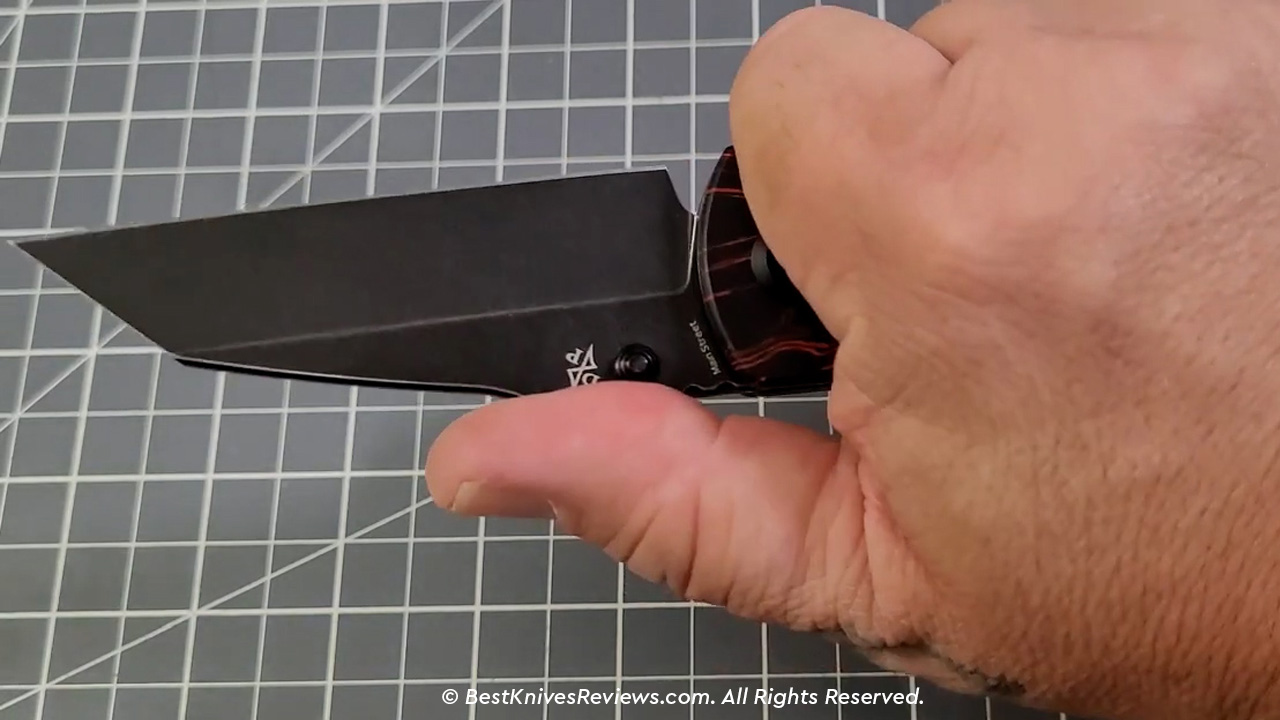
The 154CM is the standard blade steel material on the Main Street. The pricier versions feature CPM S35VN or CPM 20CV on the full Mokuti variant. The 154CM has been around since 1959 and is a modified version of 440C stainless steel with the addition of molybdenum to enhance toughness and corrosion resistance. It contains 1.05% carbon, making it a high-carbon stainless steel with 14% chromium. It is a reliable and well-balanced steel for EDC usage with a decent edge retention and corrosion resistance. It is also easy to sharpen. It is also good for its price range, being less than $100, considering it is a step up from D2 or VG10.
The Handle of Kansept Main Street
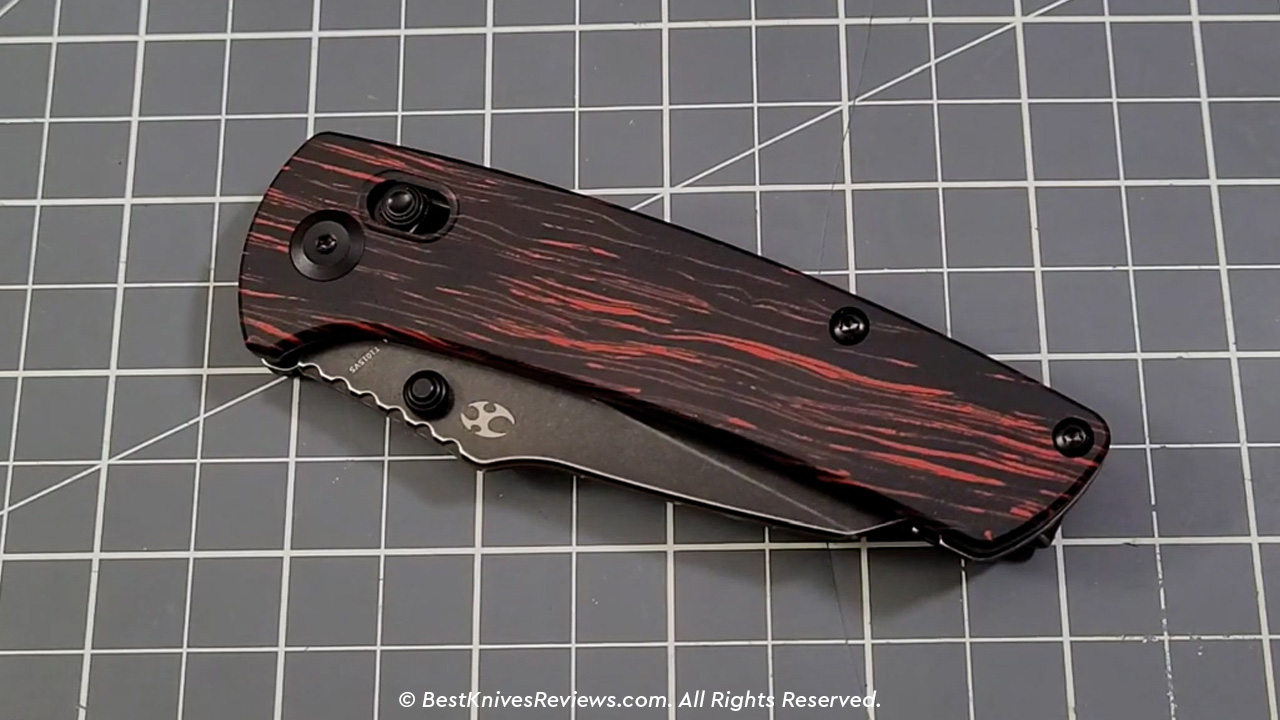
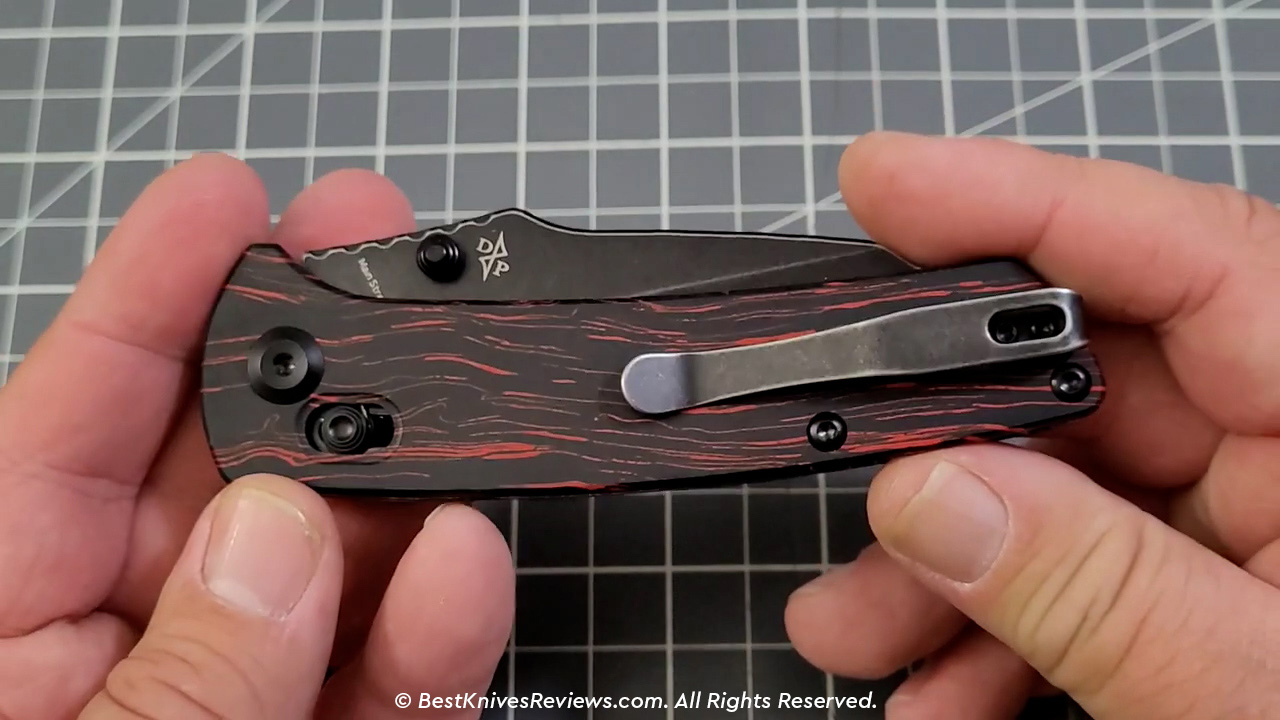
The lava-shaped red and black G-Mascus or G10 Damascus is quite attractive, with a textured surface. The scales sit atop black coated skeletonized stainless steel liners. The G10 is not nested inside the liners that increases the handle thickness to 0.48” across, slab-sided without contouring. However, there is jimping along the liners towards the spine’s rear. It is rare for there to be jimping here, since there is no purpose of it.
The hourglass-shaped standoffs make the construction flow-through supporting the liners near the rear of the scales. The body of the handle and pivot is screwed together with standard Torx fittings. The pivot screws feature Torx T10, while the body has Torx T8 screws with T6 as clip screws. The pivot screw however, is free spinning and not keyed to either the liners or the scales to prevent it from turning when adjusting it.
The pocket clip is deep carry stamped steel held together by vertical screws with a pass-through hole. It is configured for right-hand tip-up carry only with no additional screw holes. The spoon-shaped tip makes it easier to slide it in and out of the pocket, and stays in place without creating any hotspots. It does a pretty good job of fully concealing the knife inside the pocket.
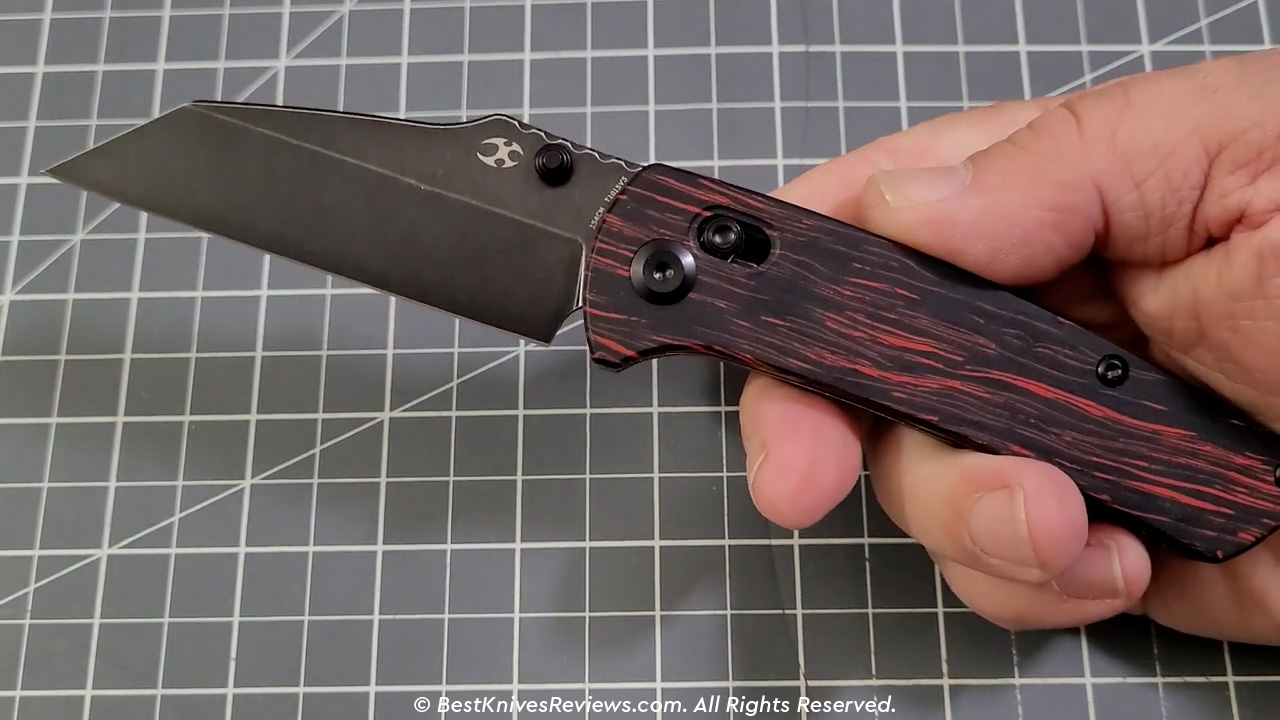
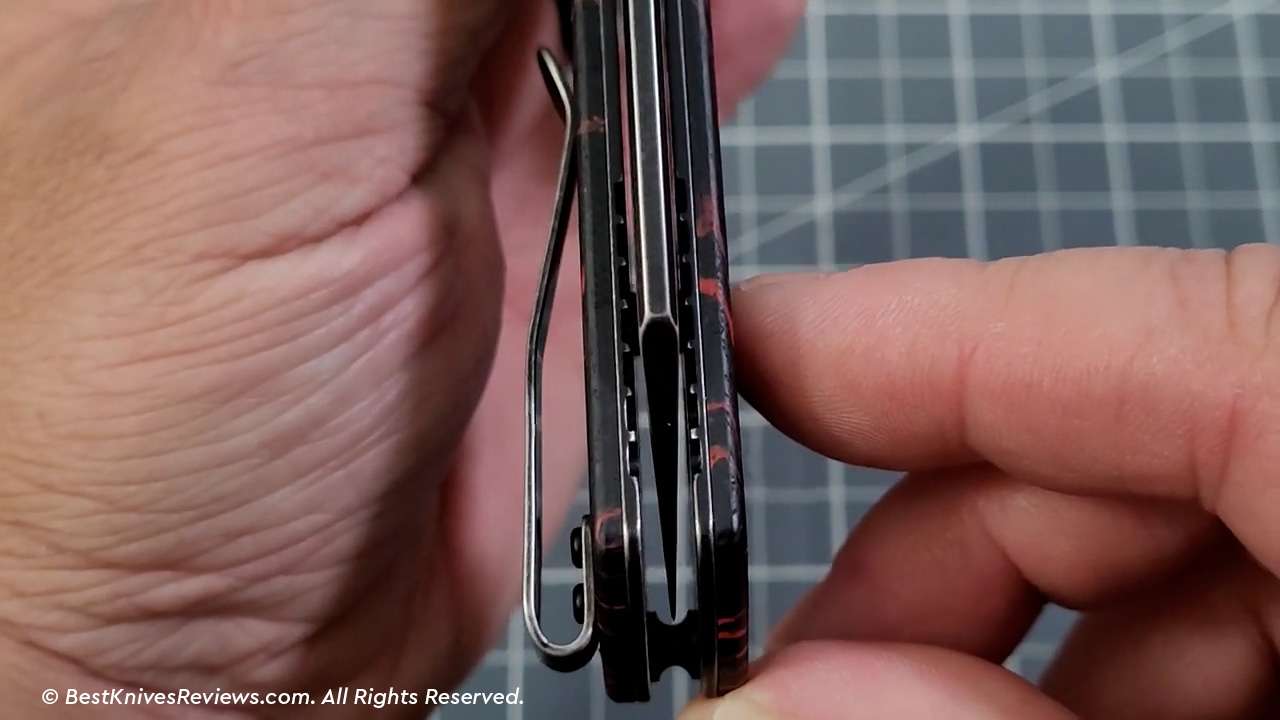
The fit and finish of the knife is good, except for the lock stick with not an impressive factory edge. A few passes on the high-grit wheel would have done it good with tiny voids in the handle scales. The blade also does not move from its spot once opened and is perfectly centered and aligned. The grind including the beveled spine is perfectly symmetrical and clean cut and no body screws protrude out to create rough edges. So the quality and design are both top-notch, but the quality still supersedes the design spectrum.
Deployment and Lockup of Kansept Main Street
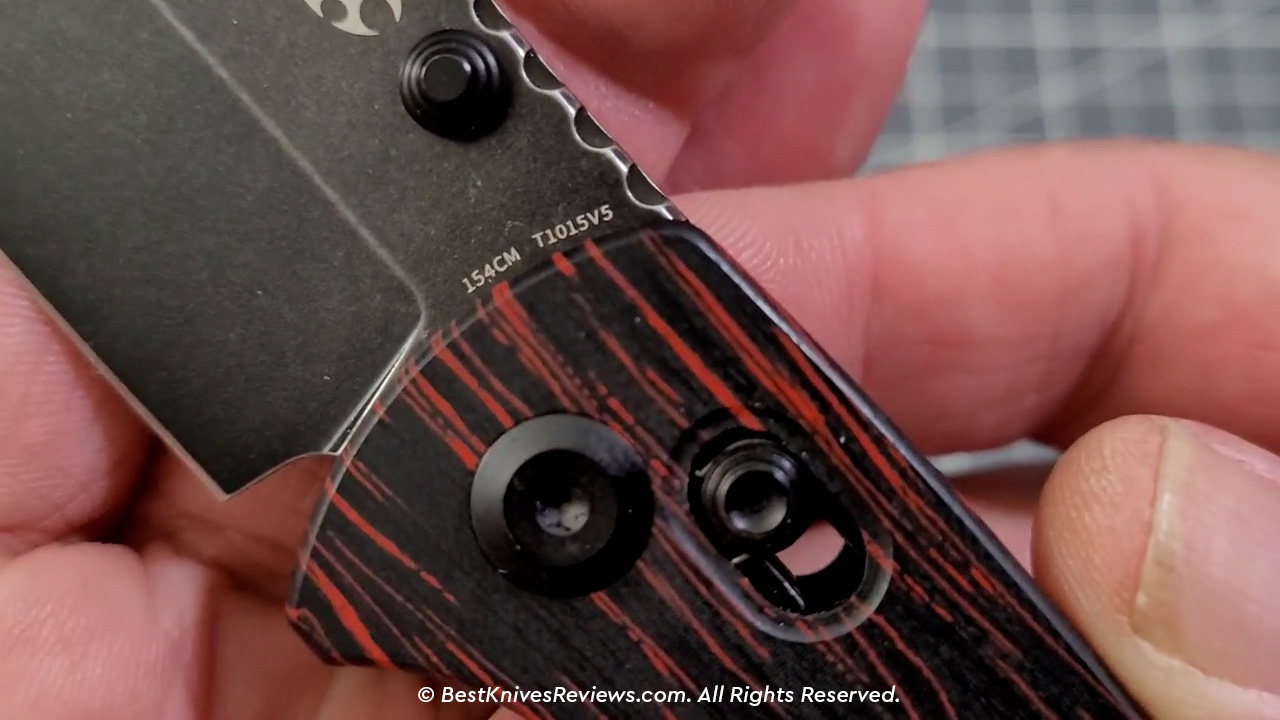
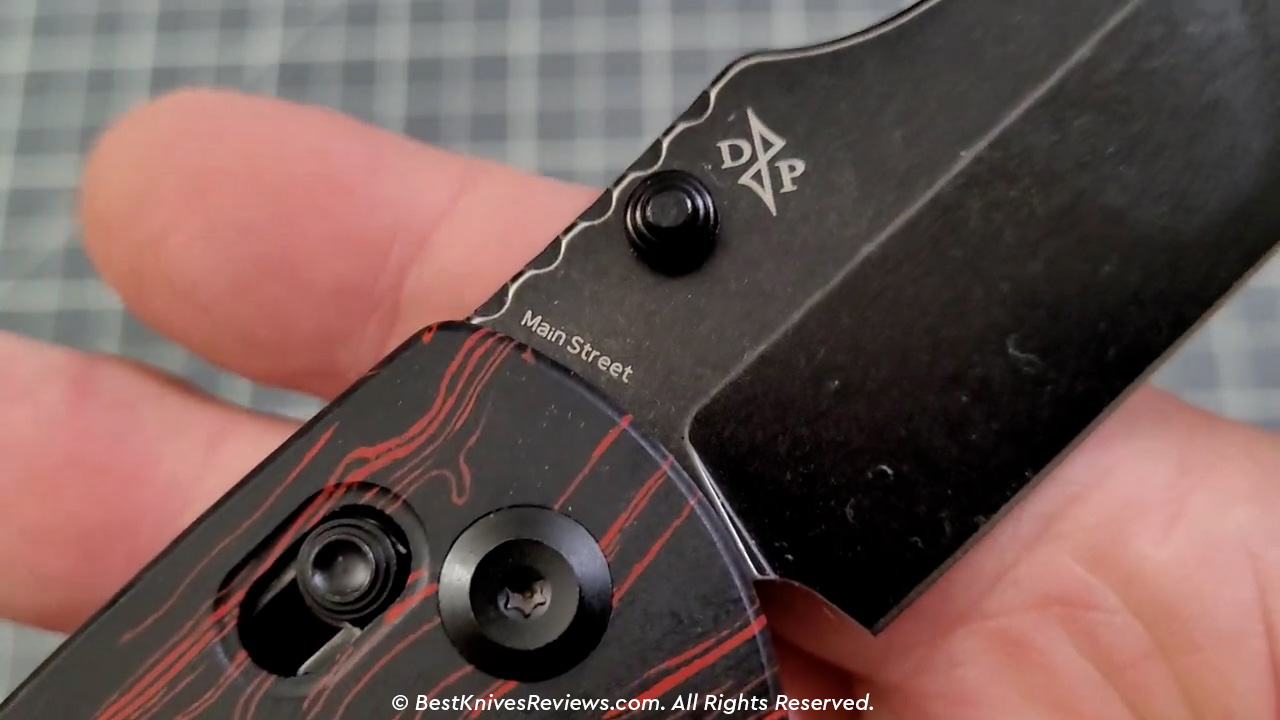
The Main Street features a thumb stud for deployment and a crossbar locking mechanism for opening and closing the knife. It includes a set of ambidextrous thumb studs with a stepped design for traction. The crossbar lock is another name for sliding bar lock, also known as AXIS lock with a set of caged ball bearings in the pivot. Just like the sliding bar lock, the Kansept Main Street uses dual Omega-shaped strings to slide the lock bar over the blade’s tang in open and closed position. It also comes with an external stop pin locating the blade in an open position.
The crossbar lock is featured on the second version of Main Street after the original liner lock. Both are available depending on customer preference. The only difference is that the liner lock makes the knife half an ounce lighter.
The sliding bar combined with the caged pivot ball bearings makes an excellent combo and deploys well. The detent is light and the ball bearings are low-friction in the pivot. That, combined with a heavier blade, allows snappy and effortless deployment. The weights are so well-balanced that the knife can drop shut under its own weight, since the open lock removes friction from the blade’s tang. The thumb stud only requires a light tension in order for it to flick open smoothly.
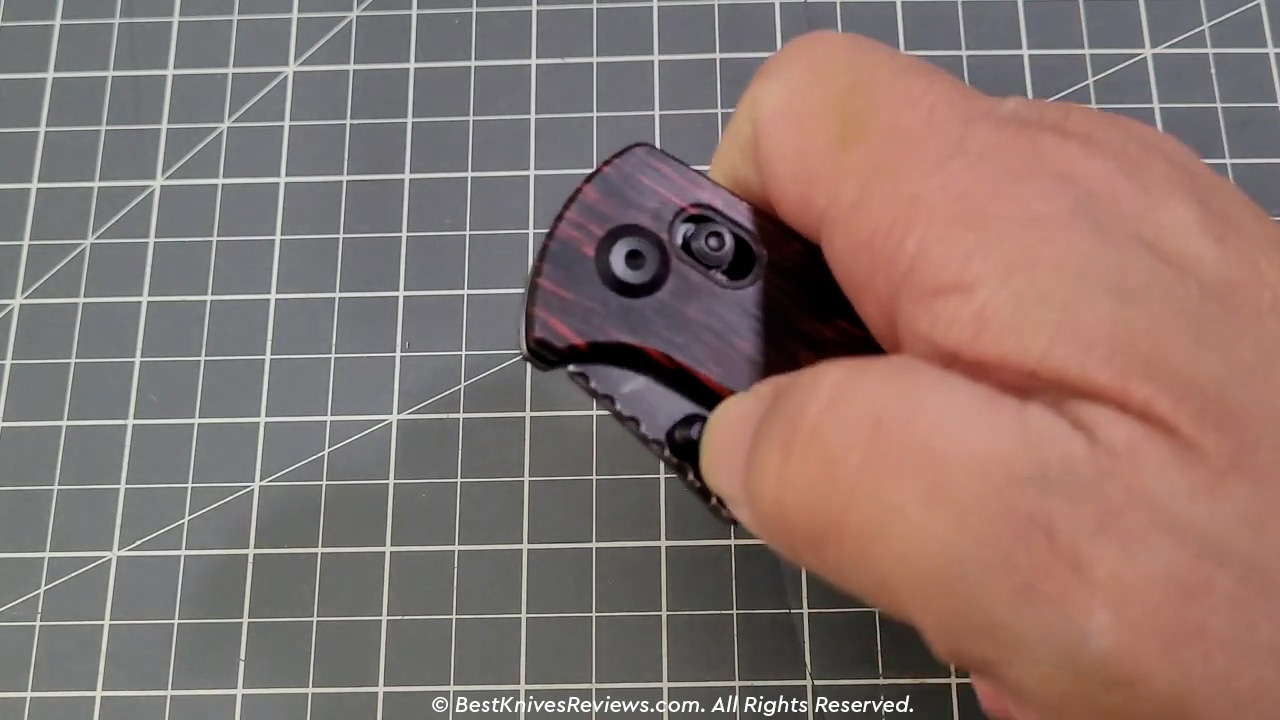
Alternatively, pulling back on the lock along with a slight wrist flick also propels the blade right open. Leaving more space for the thumbs to access the thumb studs does benefit the handle’s shape.
The only hitch with the lockup is the noticeable lock stick after flicking the blade out hard. The lock makes a soft ‘pop’ when released due to a poor machining on the blade’s tang or galling. It does not go away either. Either way, the blade does not show any signs of blade play, either vertical or horizontal. So you may as well ignore this small bump.
Field Test of Kansept Main Street
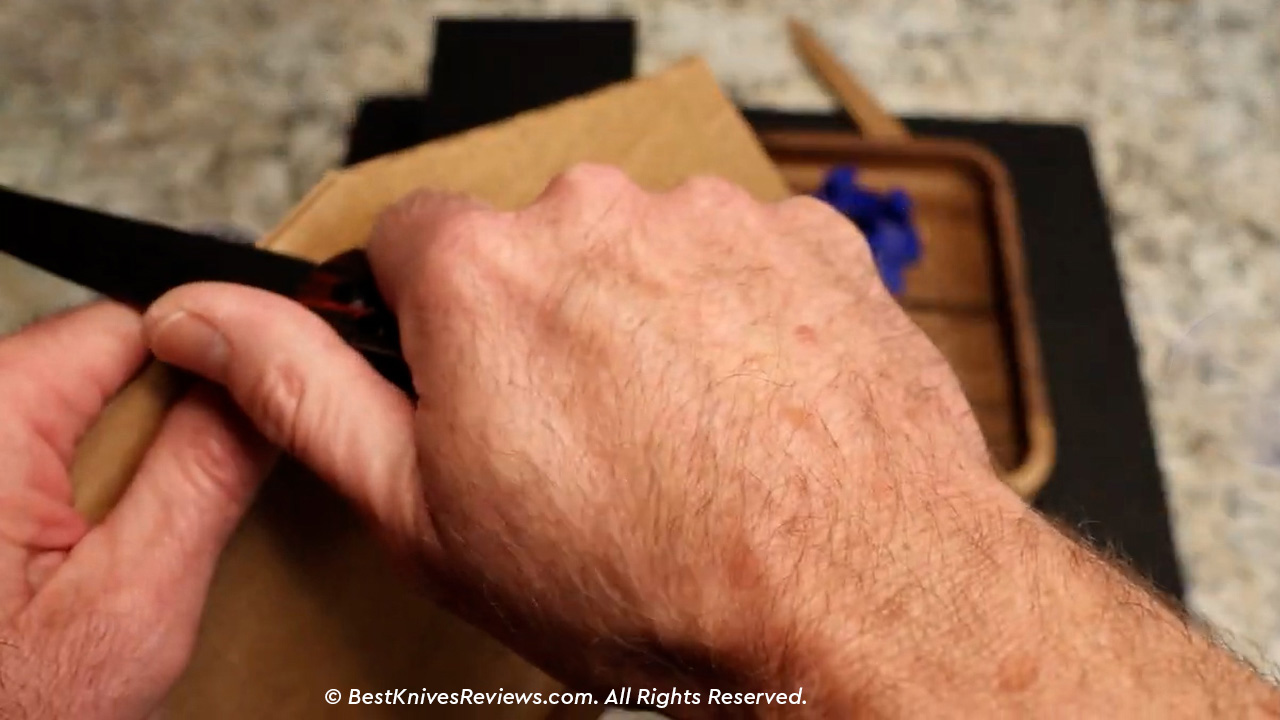
The Kansept Main Street feels bulkier and wider when held, although not too much for convenience. It carries well in the pocket and does not create any hotspots. However, the blade protruding out can feel like a nuisance when carrying it around as it takes up more space in the pocket. But at 4.5 ounces, the knife does feel a bit heavy and bulky in the pocket.
The knife does however, provide excellent cutting performance. The thin blade stock combined with the high flat grind on 154CM makes cutting cardboard a pretty clean and neat job. You can continue cutting cardboard boxes and paper for extended period without the blade getting clamped, or the scales accumulating too much dirt too quickly.
The G10 scales work excellently and feel incredibly smooth and slip-free in the hand. It is also easy to flick open and close with the thumb stud and the crossbar lock. However, it does not feel great in the hand because the handle is too wide to fit in the palm of the hand and has a tiny finger guard. The straight shape of the handle also does not help much. Having bends in just the right angles would help grip the knife better. There is also no forward choil, and feels like a thick slab that does not quite fit in.
Pros & Cons of Kansept Main Street
PRO’s
Con’s
Comparison
Kansept Main Street vs Civivi Sentinel Strike
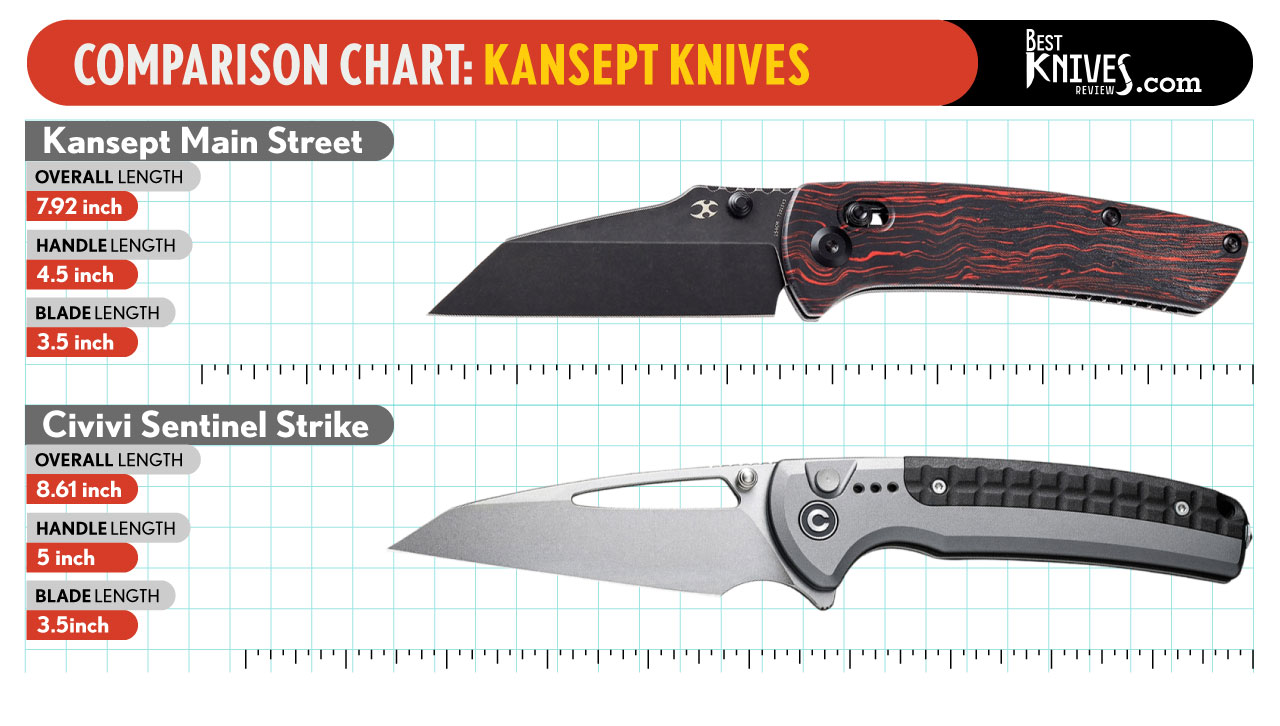
WE Knives’ Civivi Sentinel Strike is much like the Kansept Main Street with a reverse tanto blade and thumb stud. But it also comes with thumb-hole deployment and flipper tab, with a button lock. The handle features machined aluminum but with a textured overlay over the spine. The pocket clip on Sentinel Strike is deep carry anchored by glass-breaker stud. Its grind is full flat rather than high flat with a shorter profile.
It falls in similar price range as the Main Street, but comes with added bends in the handle for a firm grip.
Civivi Sentinel Strike Prices |
||
|---|---|---|
 |
 |
Check Price at Blade HQ |
 |
Check Price at Chicago Knife Works | |
Kansept Main Street vs CJRB Pyrite
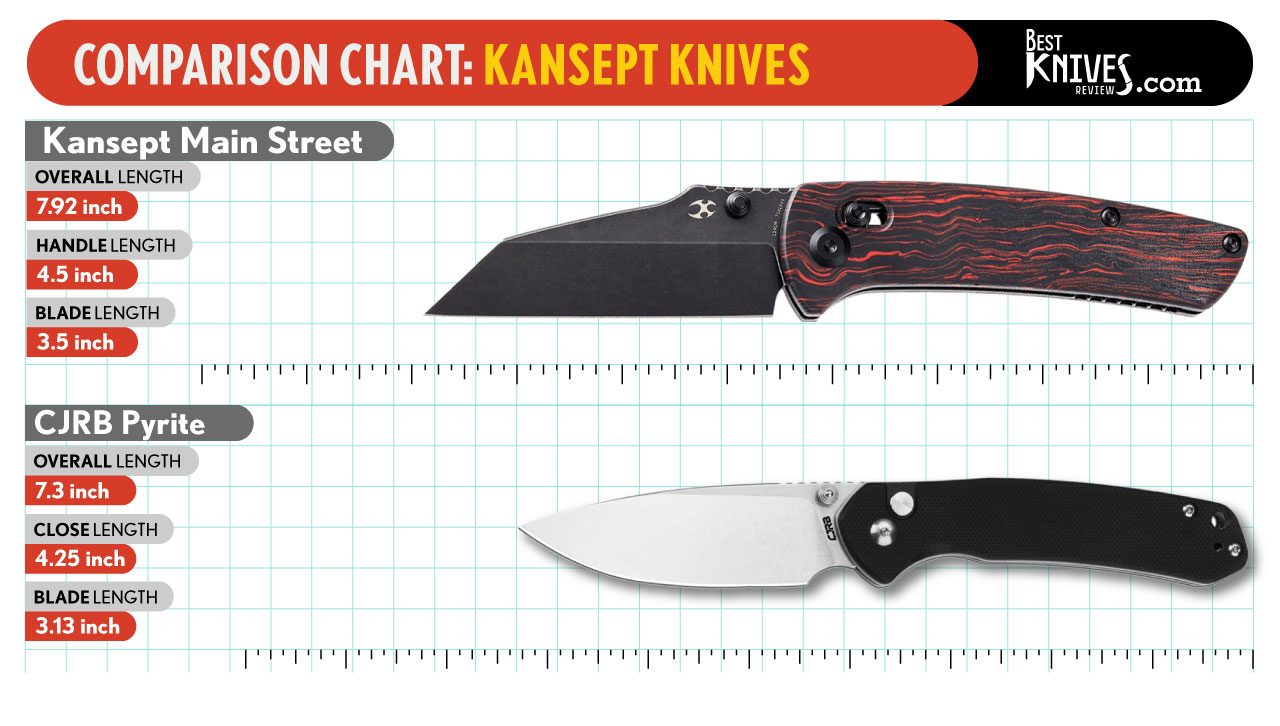
The CJRB Pyrite features 3.11” reverse tanto blade with full flat grind and thumb hole for deployment along with caged pivot ball bearings. It uses button lock as opposed to the crossbar lock on Main Street, but is 1 ounce lighter, cheaper, and has better ergonomics.
The handle profile on both the knives is much the same – it is flat. But due to the better ergonomics, the CJRB Pyrite comes on top. However, Main Street does not have bad ergonomics either. It offers a solid grip, but Pyrite is easier to flick open and shut close. It also completely disintegrates when in closed position, making it easier to carry.
CJRB Pyrite Prices |
||
|---|---|---|
 |
 |
Check Price at Blade HQ |
 |
Check Price at Chicago Knife Works | |
Conclusion Kansept Main Street
The Kansept Main Street is a good EDC knife for light to medium EDC tasks. It weighs under 5 ounces, but due to its wide handle and the back of the blade protruding out, it is difficult to carry. Although the pocket clip is well-placed and is configured for right hand tip-up carry. You can carry it in your pocket discreetly and without creating any hotspots. But it does take up more space in the pocket.
The 154CM reverse tanto blade with high flat grind combined with the light detent and thin blade stock makes for an excellent blade profile on this knife. The G10 scales are textured, comfortable and slip-proof, but the handle is too straight to fit into the palm and knuckles.
The thumb stud and crossbar lock work very well without any blade play. The blade fits perfectly aligned within the skeletonized stainless steel liners, making the knife weigh less.
It costs less than $100, and comes close to Civivi Sentinel Strike and CJRB Pyrite as its alternatives.
